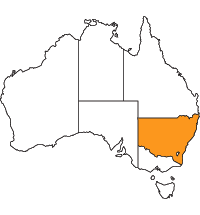Protected Areas in New South Wales, Australia
New South Wales has 877 national parks and reserves. They protect landscapes from rainforests and rugged bush to marine wonderlands and outback deserts.
You'll find campsites ranging from luxurious settings to quiet wilderness clearings, and walking tracks to suit every level of experience.
National Parks
These are areas protected for their unspoiled landscapes and native plants and animals. They are set aside for conservation and public enjoyment, and usually offer visitor facilities.
Nature Reserves
These are areas of special scientific and conservation interest, set up mainly to protect their native plant and animal communities. Few have visitor facilities.
State Conservation Areas
These are parks, often containing important natural environments, which have been set aside for conservation, public enjoyment and potential exploration.
Regional Parks
These parks offer open spaces for recreational use and cultural activities. Their environments have often been largely altered since colonisation.
Aboriginal Areas
These are places that have significance for Aboriginal people, or contain objects of Aboriginal culture. They're managed in accordance with the cultural values of the Aboriginal people whose heritage they belong to.
Historic Sites
These are sites of national cultural importance. They include buildings, objects, monuments and landscapes. Historic sites are generally open to visitors.
Karst Conservation Reserves
These are outstanding cave areas that offer unique experiences with their spectacular beauty and stunning surroundings. They include Jenolan, Wombeyan, Abercrombie and Borenore caves.
Marine Parks
These are unique and outstanding marine areas, set aside to conserve seawater plants and animals. They're divided into zones that allow different, sustainable levels of commercial and recreational activities. They are managed by the Marine Parks Authority.
Aquatic Reserves
Aquatic reserves have been established to protect biodiversity and provide representative samples of our wonderfully varied marine life and habitats.
They are managed by the Marine Parks Authority.
 The Australian Alps National Parks The Australian Alps National Parks
Stretching from Canberra through the Brindabella Range to the Snowy Mountains of New South Wales and along the Great Divide through eastern Victoria, Australia's alpine and subalpine environments are unique and special. The Australian Alps National Parks are:
- Tidbinbilla Nature Reserve
- Brindabella National Park
- Bimberi Nature Reserve
- Namadgi National Park
- Scabby Range Nature Reserve
- Kosciuszko National Park
- Alpine National Park
- Mount Buffalo National Park
- Snowy River National Park
- Avon Wilderness
- Baw Baw National Park
World Heritage-listed areas
- Gondwana Rainforests of Australia (www)
- Greater Blue Mountains (www)
- Lord Howe Island Groupexternal (www)
- Willandra Lakes Regionexternal (www)
- Australian Convict Sites (www)
Ramsar Wetlands
Ramsar wetlands are internationally significant sites. They are listed in the Ramsar Convention, which plays a key role in their conservation and wise use.
The Ramsar Sites in NSW
- Blue Lake (www)
- Fivebough and Tuckerbil wetlands (www)
- Gwydir wetlands (www)
- Hunter Estuary wetlands (www)
- Lake Pinaroo (www)
- Little Llangothlin Lagoon (www)
- Macquarie Marshes (www)
- Myall Lakes (www)
- Narran Lake (www)
- NSW Central Murray state forests (www)
- Paroo River Wetlands (www)
- Towra Point (www)
Sources: NSW Government - Office of Environment & Heritage - NSW National Parks & Wildlife Service - The Australian Alps National Parks - NSW Marine Parks Authority
|


